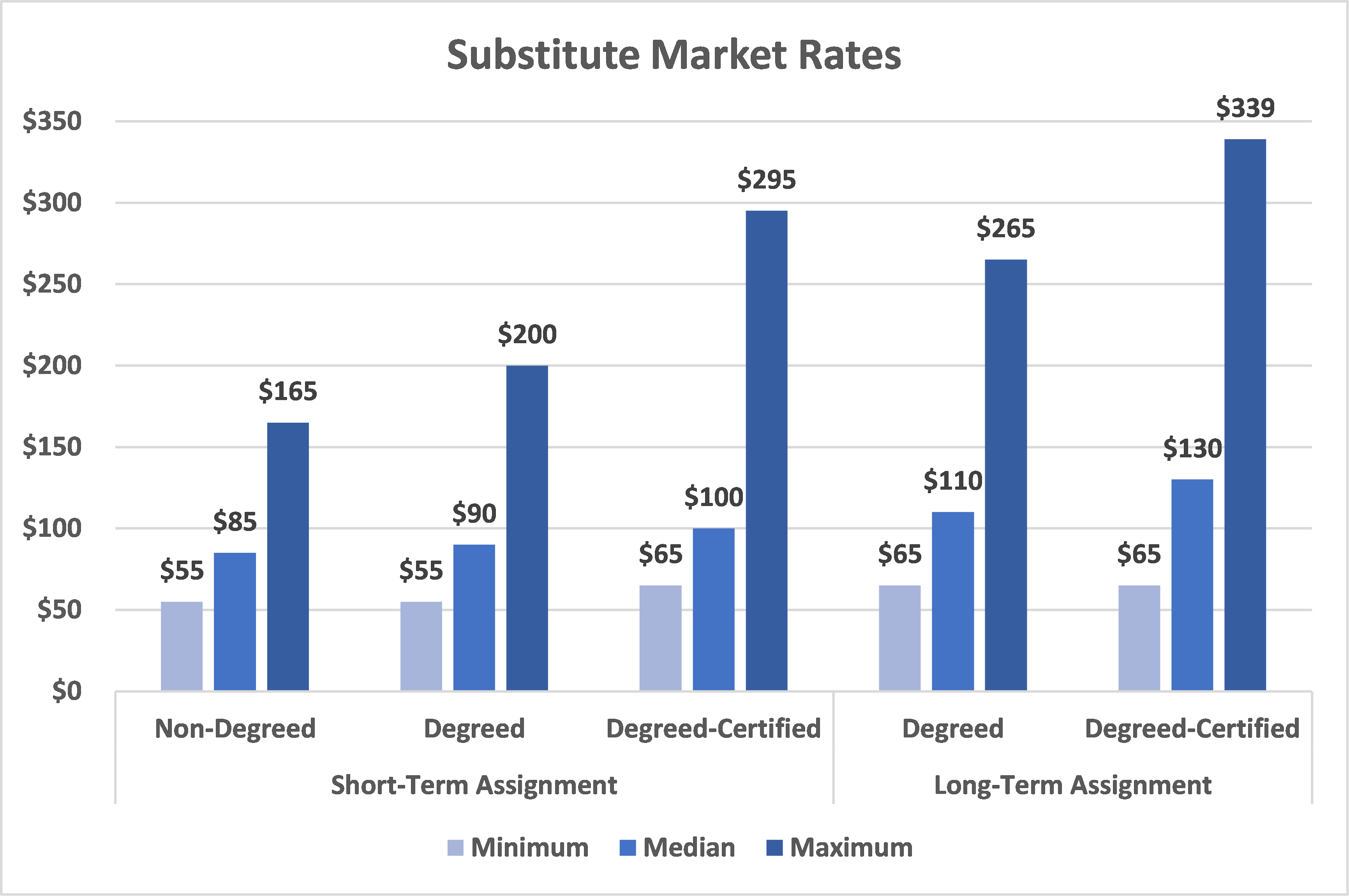Supporting Substitute Teachers
In education, the focus of support tends to be directly connected to teachers. However, substitute teachers, the unsung heroes of our schools, also need strong support to be highly effective in their role.
Substitute Teachers: A Critical Need
Substitute teachers are critical to the functioning of public schools. They keep our schools running when teachers are absent, and they often fill long-term and vacant positions providing a greater impact within the school.
According to Education Week, by the time a student graduates from high school, they will have spent upwards of 8 percent of their public schooling with a substitute teacher. This equates to an average of one school year, and in many school districts, the time could be greater depending on the challenges at the campus in finding qualified teachers.
Finding willing and competent substitute teachers is as challenging as finding highly qualified teachers in the current environment of public education. With continued staffing shortages, as well as schools facing the increased challenge of mid-year resignations of teachers, the role of the substitute teacher has sparked ongoing discussions with district leaders on how to effectively recruit, retain, and compensate substitute teachers to serve in public schools.
The Experience of the Substitute Teacher
Substitute teaching and the need for substitute teachers have evolved over the years. In the past, schools required fewer substitute teachers and the candidate pool was large. Currently, the need for substitute teachers has skyrocketed in schools, yet the pool has become shallower and filled with less qualified candidates, especially in the post-pandemic years.
The challenge to finding substitute teachers often lies with the required duties and responsibilities, as well as the treatment and support given to the substitute teacher on any given day. Substitute teachers are often seen as babysitters and regarded as “not really teachers.” Additionally, the pay for the job can be dismal depending on the assignment and the district in which the substitute teacher serves.
Through exit interviews and surveys, substitute teachers often communicate their classroom experiences as unsatisfactory due to weak or nonexistent support from campus administrators, lack of respect from students and staff, minimal training, and misalignment between the work required and adequate compensation. The conditions in which many substitute teachers work lead to a negative experience, and many aren’t willing to commit to the job due to these detractors.
Change the Narrative
Substitute teachers want to work on campuses where they feel supported, included, and connected. They want respect and to be seen as critical members of the learning community. They also want to be paid fairly for their contributions to the school. In other words, substitute teachers want what any full-time employee wants — to be recognized for the value they bring to the campus and the job.
To shift current practices and to change the narrative of substitute teachers feeling marginalized or unappreciated, district leaders need to be intentional about how substitute teachers are viewed. This includes the critical role they serve and how the district can’t function without their support in classrooms. Messaging is key to how substitute teachers are seen within the district, and the message starts with district leaders and administrators.
Strategies to Support Substitute Teachers
As with any other critical area in schools, the management of substitute teachers needs to be systems-oriented. District leaders need to be intentional in their expectations for the treatment and support of substitute teachers and communicate these expectations to campus administrators and their staff. Leaders also need to lead the charge in supporting adequate compensation and ensuring substitute teachers are paid fairly for the value they bring to the district.
One approach to supporting substitute teachers could be to create a model that defines the vision, role, and expectations of substitute teachers in the district. The model could identify the desirable characteristics of a quality substitute teacher which would then lead to creating actionable steps to recruit, train, support, and retain substitutes throughout the year. It will also help the district define the type of substitute, the credentials needed to serve at specific campuses or assignments, the expectations of the substitute, and what the substitute can expect from the district and the campus. As with the creation of any model of support, collaboration with key stakeholders should occur.
Another approach to supporting substitute teachers could be simply with information gathering. District leaders can determine how substitute teachers are faring in their schools by acquiring anecdotal data which will help them learn if substitute teachers feel supported, have the tools for success, and if they believe they are being compensated fairly.
Surveys are a great tool to use to determine areas of needed improvement. District HR departments could also conduct small, focused interview sessions to gather information. How the information is used to create improvements is key to developing an actionable plan of support for substitute teachers.
A few questions district leaders could ask include:
- Is the role of the substitute teacher clearly defined, and are expectations at each campus consistent?
- Is current training adequate to help substitute teachers be successful across campuses and in a variety of classrooms?
- What additional areas of support are needed to build the skills of substitute teachers?
- Do substitute teachers feel welcomed and respected at campuses? Do they feel supported by campus administrators?
- Do substitute pay rates seem fair for the work conducted in the role? What other incentives could communicate how the district values substitute teachers?
Supporting substitute teachers in a proactive and positive way should be the mission and goal for school districts. Substitute teachers are critical in providing continuity of instruction in the teacher’s absence, and they help build student achievement and success over the year.
Compensating Substitute Teachers
Creating conditions where substitutes feel supported and valued will help districts recruit and retain quality substitute teachers. Providing support and respect are key factors. However, so are compensating and rewarding these critical employees for their work with district schools.
Market data for substitute teacher pay from the 2023-2024 TASB salary survey is provided below. The median enrollment for all districts is 1,912 students, with 544 participants representing school districts of different enrollment sizes and types completing the survey. The minimum and maximum daily rates are provided, as well as the market median for each category.

Overall, the data reflects how districts value degreed-certified substitutes, especially in long-term assignments. The data also shows very little variance between short-term and long-term assignments for those individuals who are both non-degreed and degreed. Additionally, some districts in the state are paying competitively while others aren’t.
For HR Services member districts who would like to see market comparisons for substitute pay, TASB HRDataSource™ is a valuable resource. To view substitute teacher pay data, log into HRDataSource, choose Salary and FTE Reports, then Teacher Pay. Select the criteria for the report to include comparison districts of similar size. The report will then display in the browser, and it can be downloaded in Excel for specific information about substitute pay rates.
District leaders struggling with finding and keeping substitute teachers, as well as the management of these critical employees, may need to change current thinking. With intentionality and a systems-thinking approach to the role of the substitute teacher, districts may find improved hiring and fill rates, as well as be able to hire quality candidates who bring experience and value to the classrooms they serve.
Information gathering is a good place to begin the process of conducting an honest assessment of current strategies in substitute teacher management in the district. From the information gathered, areas of need should be identified. Having an open mindset and setting aside past assumptions may help districts find new ways to build a robust pool of qualified substitute teachers. Focusing on these critical employees may help not only the substitute teacher, but also the campuses and students they serve.
For additional information about substitute best practices and employing substitute teachers, guidance can be found by searching for "substitute" in the HR Services Resource Library (member login required).
Additional information about hiring great substitute teachers can be found in the HRX article Hiring Great Substitute Teachers.

Jennifer Barton
Jennifer Barton joined HR Services in 2018. She supervises a team of consultants providing staffing reviews, HR consulting, and employee opinion surveys for Texas school districts. In addition to overseeing and conducting consulting projects, Barton provides training and guidance to district leaders and assists with resource planning and development for HR Services.
Barton earned master’s degrees in education and educational leadership from The University of Texas at Austin and Lamar University. She holds a Texas superintendent certificate and is a SHRM-CP.
HR Services

Subscribe to HRX
Stay up to date with all the latest HR news and trends by joining the HRX mailing list!





